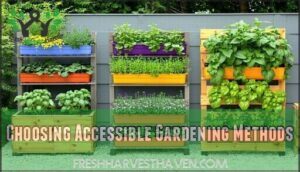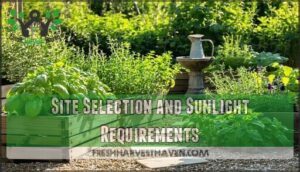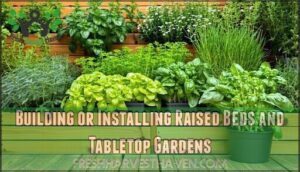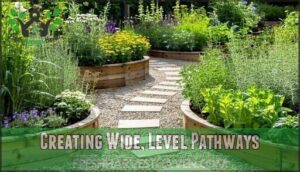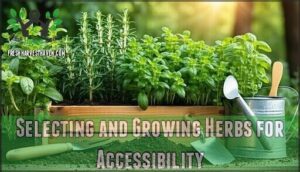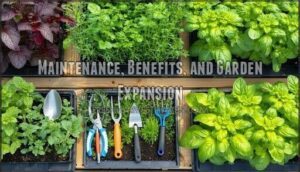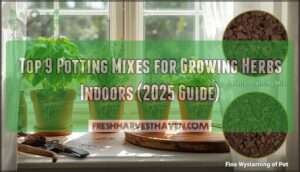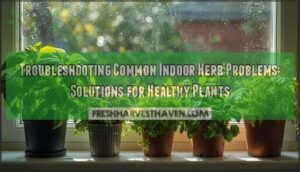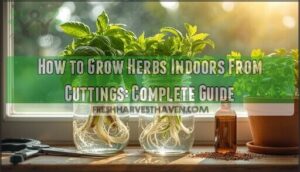This site is supported by our readers. We may earn a commission, at no cost to you, if you purchase through links.
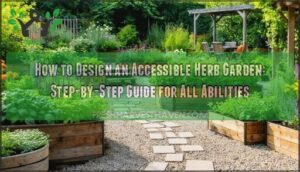
You don’t need to give up gardening as your body changes. With raised beds at the right height, wide pathways, and smart plant choices, you can create a space that works with your abilities instead of against them.
This guide walks you through each step, from choosing the best setup to selecting low-maintenance herbs that practically care for themselves.
Table Of Contents
Key Takeaways
- Accessible herb gardens use raised beds (24 inches for wheelchairs, 30-36 inches for standing) and wide pathways (at least 36-48 inches) to eliminate bending, kneeling, and strain while maintaining full access to fresh herbs.
- Low-maintenance perennial herbs like rosemary, thyme, and oregano thrive with minimal watering and natural pest resistance, making them ideal choices for gardeners who need simplified care routines.
- Research shows horticultural therapy programs reduce stress and anxiety while improving cognitive function, physical health, and social well-being across all ages and abilities.
- Building costs range from $50 for basic containers to $500+ for custom raised beds, with DIY approaches and community grants helping make accessible gardening affordable for most budgets.
Key Principles of Accessible Herb Garden Design
Building an herb garden that’s truly accessible starts with a few key design ideas. These principles aren’t complicated, but they make a world of difference.
Let’s look closer at what sets an accessible garden apart.
Raised Beds and Tabletop Gardens
Raised beds and tabletop gardens open the door to growing fresh herbs, no matter your mobility or experience. By lifting the planting area up, you make gardening comfortable and within reach. When planning your accessible herb garden, consider:
- Raised beds for flexible bed height and easy reach
- Tabletop gardens with the right tabletop depth for seated tasks
- Pathway width and seating options for smooth access
Optimal Bed Heights and Widths
Once you’ve chosen raised beds or tabletop gardens, you’ll need to get the dimensions right for accessible gardening. Wheelchair access usually calls for beds at 24 inches high, while standing heights work best around 30 to 36 inches to reduce bending.
Keep reach limits in mind—garden accessibility features improve when gardening beds stay 2 to 3 feet wide for wheelchair users and up to 4 feet for others. Deeper beds mean more soil volume and cost implications, but they support healthier roots in creating accessible gardens.
Consider that lumber comes in standard lengths to minimize material waste.
Pathway Dimensions and Surface Requirements
Pathway design matters just as much as bed height for creating accessible gardens. You need adequate pathway widths—at least 36 inches for wheelchair clearance, though 48 inches works better for passing or turning. Surface materials must be firm and slip-resistant. One way to make gardening more accessible is by using raised garden beds.
Here’s what makes garden accessibility features successful:
- Firm surfaces like concrete or compacted pavers prevent mobility aid struggles
- Drainage solutions keep paths dry and safe by directing water away
- Minimal slope gradients (under 5%) support independent wheelchair navigation
- Regular maintenance prevents cracks or debris from blocking access
Stable, level pathways create true accessibility and mobility freedom in your herb garden.
Seating Edges and Comfort Features
Comfortable seating edges transform your raised beds from simple planters into inviting spaces where you can rest and work without strain. Build edges 8 to 18 inches wide for ergonomic seating with optional back support or armrests options.
Consider weather protection through shaded areas or overhead structures.
These adaptive gardening techniques improve mobility and accessibility while making your accessible garden design more functional for extended gardening sessions with ergonomic tools nearby.
Choosing Accessible Gardening Methods
Not all accessible herb gardens look the same, and that’s a good thing. The method you choose depends on your physical needs, available space, and how much effort you want to put into building or buying your setup.
Let’s look at three main options that work well for gardeners with varying abilities.
Raised Beds Vs. Tabletop Gardens Vs. Containers
You can choose among raised beds, tabletop gardens, and containers depending on your mobility access and space considerations.
Raised beds offer the most planting room and material durability, while tabletop gardens provide better accessibility for wheelchair users. Containers work well for adaptive gardening in tight spaces and often have lower cost comparison points.
Each option has distinct aesthetic appeal, so think about what fits your needs best.
Selecting Containers for Limited Mobility
When you’re working with limited mobility, the right container can make all the difference between frustration and the simple joy of tending herbs. Here are four essential features to look for:
- Lightweight materials like plastic or resin that won’t strain your arms when moving them
- Self-watering options that reduce how often you need to water
- Container height between 24-30 inches so you can reach from a wheelchair or while standing
- Drainage solutions with pre-drilled holes spaced 3-4 inches apart to prevent root rot
Adapting Gardens for Different Abilities
Beyond the physical structure of your garden, consider how different minds and senses experience the space. Cognitive adaptations like simple plant labels with pictures support memory challenges, while sensory gardens featuring fragrant herbs like mint and lavender create inclusive design for everyone.
Adaptive tools—ergonomic pruners, long-handled cultivators—transform disability gardening into joyful universal access. Whether you’re adapting gardens for aging gardeners or creating accessible gardening spaces for varied abilities, the key is personalizing features to match individual needs, making garden accessibility a reality for all.
Step-by-Step Guide to Building an Accessible Herb Garden
Now that you’ve chosen your accessible gardening method, it’s time to bring your herb garden to life. Building an accessible garden involves three key steps: finding the right spot, setting up your beds or tables, and ensuring your pathways work for everyone.
Let’s walk through each step so you can create a space that’s both functional and inviting.
Site Selection and Sunlight Requirements
Your herbs need a sun-soaked spot to thrive—think of a location where they’ll soak up 6 to 8 hours of direct sunlight each day. Here’s what to think about when choosing your site:
- Ideal Sunlight: Track how sunlight moves across your space throughout the day.
- Soil Quality: Look for loamy, well-drained soil—avoid waterlogged or clay-heavy areas.
- Water Access: Position your garden near a water source for easy watering.
- Space Considerations: Make sure there’s room for pathways and comfortable movement.
- Microclimates: Notice sheltered spots that might offer protection from harsh winds.
Garden accessibility starts with thoughtful garden design from the ground up.
Building or Installing Raised Beds and Tabletop Gardens
Raised beds and tabletop gardens turn your herb-growing dreams into a reality you can reach without strain or struggle. Start with bed material options like cedar, steel, or composite wood—each offers durability and style. DIY construction tips help you customize dimensions to fit your needs, while pre-made options save time if you’re ready to plant quickly.
Cost considerations vary, but accessible gardening doesn’t have to break the bank. Tabletop gardens work beautifully for wheelchair users, and raised beds suit those who prefer standing. This garden design approach makes gardening for people with disabilities both practical and joyful.
Creating Wide, Level Pathways
Pathways act as the backbone of your accessible herb garden, connecting you to every plant without obstacles or frustration. Here’s what matters most for mobility-friendly design:
- Width: Aim for at least 4 feet wide to guarantee wheelchair clearance and room for walkers or wheelbarrows.
- Surface Firmness: Choose pathway materials like compacted gravel, pavers, or concrete for stability.
- Slope Considerations: Keep paths level to prevent tipping or strain.
- Obstacle Avoidance: Remove roots, rocks, and edges that create trip hazards.
This inclusive gardening approach transforms your garden design for mobility into a space that welcomes everyone.
Selecting and Growing Herbs for Accessibility
Choosing the right herbs makes all the difference in creating a garden that’s truly easy to care for. You’ll want plants that don’t demand constant attention, forgive occasional mistakes, and thrive in accessible growing setups.
Let’s look at which herbs work best for low-maintenance gardening and how to keep them healthy with simple care routines.
Best Herbs for Easy Maintenance
Starting your herb journey doesn’t mean tackling high-maintenance plants. Focus on drought-tolerant herbs like rosemary and thyme, which need minimal watering once established. Pest-resistant varieties such as mint and oregano thrive with little fuss, making them perfect for container gardening in small spaces. Low-allergen herbs like basil offer safer options for sensitive gardeners. Self-seeding options like dill can reduce replanting efforts in your herb garden.
| Herb Type | Key Maintenance Benefit |
|---|---|
| Rosemary | Drought-tolerant, minimal pruning needed |
| Oregano | Pest-resistant, spreads easily |
| Chives | Self-seeding, low-maintenance plants |
| Sage | Hardy, requires infrequent watering |
These low-maintenance plants simplify herb care while delivering fresh flavors for your kitchen.
Perennial Vs. Annual Herb Choices
Choosing between perennials and annuals shapes how much effort you’ll put into your garden each year. Perennials like thyme and oregano reduce replanting workload while building an established herb garden over time.
Annuals such as basil offer bold flavor profiles but require seasonal replanting. Mixing both types balances sustainable gardening practices with fresh variety in your plant care routine.
Soil, Drainage, and Container Tips
Good soil and proper drainage make or break your herb garden’s success, especially when you’re working with raised beds or containers. Here’s how to set up healthy growing conditions:
- Use loamy, well-drained soil – Herbs rarely need fertilizer when soil composition fosters root health naturally.
- Add drainage holes every 3-4 inches – Container drainage prevents waterlogged soil and root rot.
- Choose containers at least 6 inches deep – Twelve inches works better for larger herbs in small space gardening.
- Pick lightweight plastic pots – They’re easier to move if you have limited upper body strength.
- Test watering techniques regularly – Soil should feel moist but never soggy between waterings.
Pruning, Watering, and Fertilizing Essentials
Once your soil and containers are in place, regular care keeps your herbs thriving without demanding too much time or energy. Water when the top inch feels dry—frequency depends on weather and container size.
Most herbs need little fertilizer, but a light feeding every 4-6 weeks encourages growth. Pruning techniques like pinching stems back encourage bushier plants and fresh harvests.
Check leaves regularly for pests to catch problems early.
Maintenance, Benefits, and Garden Expansion
Once your accessible herb garden is up and running, keeping it thriving doesn’t have to be complicated. The real magic happens when you see how your garden grows alongside you—physically, mentally, and even spiritually.
Let’s look at how to maintain your space, expand what’s working, and embrace the deeper rewards that come with tending herbs.
Low-Maintenance Care Routines
Your herbs don’t need pampering—just a simple routine that keeps them thriving without constant attention. Water when the top inch of soil feels dry, checking raised beds more often in summer heat.
Most herbs resist pests naturally, so you’ll rarely deal with problems. Healthy soil and seasonal adjustments—like mulching before winter—keep your low-maintenance herb garden productive year-round.
Dividing, Replanting, and Adding New Herbs
As your herb garden matures, dividing overgrown plants breathes new life into tired clumps while giving you extras to expand your collection. Split perennials like mint or chives in spring using simple propagation methods—gently separate roots and replant in fresh containers.
Herb division keeps plants vigorous while seasonal additions introduce exciting variety. Growing herbs at home becomes more rewarding as your container gardening for herbs expands, keeping your accessible garden interesting year-round.
Therapeutic and Wellness Benefits
Beyond the joy of fresh basil and thyme, accessible herb gardens deliver powerful therapeutic benefits backed by research. Horticultural therapy programs show significant results—studies found stress reduction and improved cognitive function among participants across all ages. Garden therapy benefits extend to comprehensive wellness, with meaningful improvements in physical health and social well-being.
Accessible herb gardens deliver research-backed therapeutic benefits, from stress reduction and improved cognitive function to enhanced physical health and social well-being
- Stress reduction: Programs lasting 100–500 minutes produced significant decreases in anxiety and depression
- Cognitive function: Sensory herbs like mint and rosemary enhanced attention span and engagement in both children and adults
- Social well-being: Community gardeners reported stronger connections and increased life satisfaction
- Physical health: Regular gardening provided moderate-intensity activity supporting mobility and pain management
These therapeutic benefits of gardening transform your accessible herb garden into more than a food source—it becomes a healing space.
Sustainable and Eco-Friendly Practices
An accessible herb garden doesn’t just nurture plants—it can protect the planet when you incorporate earth-friendly practices into your daily routine. Simple choices make a real difference.
| Practice | Method | Impact |
|---|---|---|
| Water Conservation | Collect rainwater in barrels; use drip irrigation | Reduces water waste by 50% or more |
| Organic Fertilizers | Apply compost tea or worm castings | Enriches soil without harmful chemicals |
| Companion Planting | Pair basil with tomatoes; marigolds deter pests | Natural pest control eliminates pesticide need |
Recycling materials for containers and using permaculture principles transforms your herb garden into an eco-friendly gardening sanctuary. These sustainable gardening practices support both your wellness and the earth’s health.
Frequently Asked Questions (FAQs)
What are the best adaptive tools for herb gardening?
Ergonomic hand tools with cushioned grips reduce strain when planting or pruning. Grip-enhancing gloves support those with arthritis.
Modified watering cans with extended spouts minimize bending. Adaptive potting benches bring work to comfortable heights.
Wheeled garden carts transport supplies easily, making therapeutic horticulture accessible for gardeners using mobility aids.
How do you control pests without bending or kneeling?
Long-handled tools let you spray organic solutions or handpick pests from above. Companion planting attracts beneficial insects that manage pest control naturally.
Elevated solutions like raised beds and thoughtful container design bring plants closer, reducing strain.
Can you automate watering in accessible herb gardens?
Think of it like having a helpful assistant who never takes a day off. Yes, automated irrigation systems work beautifully in accessible herb gardens.
Smart sensors monitor soil moisture in raised beds, triggering watering when needed. This saves water, reduces garden maintenance, and helps gardeners with disabilities stay independent.
System maintenance and cost analysis matter upfront.
What are sensory-friendly herbs for therapeutic gardens?
Lavender offers calming scents perfect for healing gardens. Chamomile provides aromatherapy combos supporting natural health.
Mint delivers invigorating taste sensations and tactile textures.
Choose aromatic herbs with visual appeal to create wellness-focused therapeutic spaces.
How much does building an accessible garden cost?
Material costs range from $50 for simple containers to $500+ for custom raised beds. DIY savings reduce expenses substantially.
Disability support programs and community grants offer funding sources for accessible gardening on a budget.
Conclusion
Think of your garden as a bridge—not the kind you cross once and forget, but one you build to connect who you were with who you’re becoming.
Designing an accessible herb garden isn’t about accommodating limits; it’s about creating freedom. With raised beds, thoughtful pathways, and low-maintenance herbs, you’ve removed the barriers between intention and harvest.
Your hands will still know the earth. Your senses will still catch basil on the breeze. The only difference? Now, nothing stands in your way.

